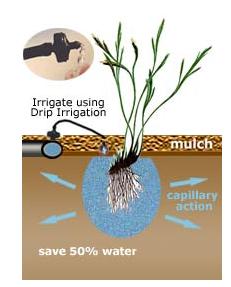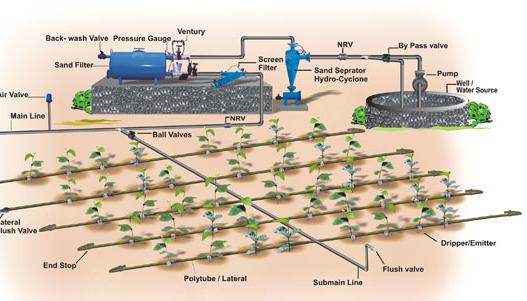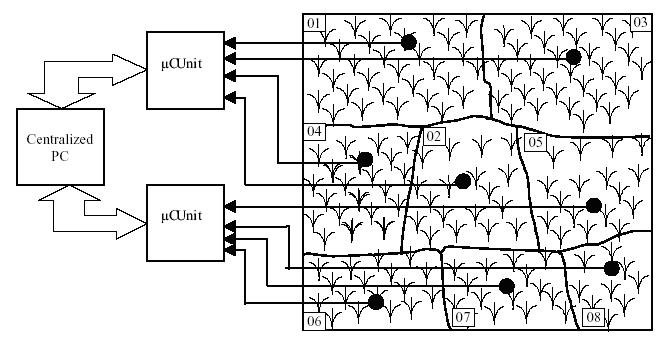Technical Paper Title: MICROCONTROLLER BASED DRIP IRRIGATION SYSTEM
Authors: P.Ashok & K.Ashok, 1st BTech, ECE
College: Prakasam Engineering College, Kandukur
Abstract
In the field of agriculture, use of proper method of irrigation is important and it is well known that irrigation by drip is very economical and efficient. In the conventional drip irrigation system, the farmer has to keep watch on irrigation timetable, which is different for different crops. The project makes the irrigation automated. With the use of low cost sensors and the simple circuitry makes this project a low cost product, which can be bought even by a poor farmer.This project is best suited for places where water is scares and has to be used in limited quantity. Also, third world countries can afford this simple and low cost solution for irrigation and obtain good yield on Crops. The heart of the project is the Intel 89c51microcontroller.UART controller that will be used in this project. A 16×2 LCD is connected to the microcontroller, which displays the humidity level and ambient temperature. Three pushbuttons are provided to set the limits of humidity for switching the individual solenoid valves controlling the water flow to the field. The humidity and temperature levels are transmitted at regular time interval to the PC through the RS232 serial port for data logging and analysis. The humidity sensors are constructed using aluminum sheets and housed in easily available materials. The aim is to use the readily available material to construct low cost sensors. Five relays are controlled by the microcontroller through the high current driver IC, ULN2003. Four relays are provided for controlling four solenoid valves, which controls the flow of water to four different parts of the field. One relay is used to shut-off the main motor which is used to pump the water to the field.
Introduction
The continuous increasing demand of the food requires the rapid improvement in food production technology. In a country like India, where the economy is mainly based on agriculture and the climatic conditions are isotropic, still we are not able to make full use of agricultural resources. The main reason is the lack of rains & scarcity of land reservoir water. The continuous extraction of water from earth is reducing the water level due to which lot of land is coming slowly in the zones of un-irrigated land. Another very important reason of this is due to unplanned use of water due to which a significant amount of water goes waste. In the modern drip irrigation systems, the most significant advantage is that water is supplied near the root zone of the plants drip by drip due to which a large quantity of water is saved. At the present era, the farmers have been using irrigation technique in India through the manual control in which the farmers irrigate the land at the regular intervals. This process sometimes consumes more water or sometimes the water reaches late due to which the crops get dried. Water deficiency can be detrimental to plants before visible wilting occurs. Slowed growth rate, lighter weight fruit follows slight water deficiency. This problem can be perfectly rectified if we use automatic micro controller based drip irrigation system in which the irrigation will take place only when there will be intense requirement of water.
Irrigation system uses valves to turn irrigation ON and OFF. These valves may be easily automated by using controllers and solenoids. Automating farm or nursery irrigation allows farmers to apply the right amount of water at the right time, regardless of the availability of labor to turn valves on and off. In addition, farmers using automation equipment are able to reduce runoff from over watering saturated soils, avoid irrigating at the wrong time of day, which will improve crop performance by ensuring adequate water and nutrients when needed. Automatic Drip Irrigation is a valuable tool for accurate soil moisture control in highly specialized greenhouse vegetable production and it is a simple, precise method for irrigation. It also helps in time saving, removal of human error in adjusting available soil moisture levels and to maximize their net profits.
The entire automation work can be divided in two sections, first is to study the basic components of irrigation system thoroughly and then to design and implement the control circuitry. So we will first see some of the basic platform of drip irrigation system.
Definition of Irrigation
Irrigation is the artificial application of water to the soil usually for assisting in growing crops. In crop production it is mainly used in dry areas and in periods of rainfall shortfalls, but also to protect plants against frost.
Types of irrigation:
- Surface irrigation
- Localized irrigation
- Drip Irrigation
- Sprinkler irrigation
Drip irrigation also known as trickle irrigation or microirrigation is an irrigation method which minimizes the use of water and fertilizer by allowing water to drip slowly to the roots of plants, either onto the soil surface or directly onto the root zone, through a network of valves, pipes, tubing, and emitters
Concept of Modern Irrigation System: – The conventional irrigation methods like overhead sprinklers, flood type feeding systems usually wet the lower leaves and stem of the plants. The entire soil surface is saturated and often stays wet long after irrigation is completed. Such condition promotes infections by leaf mold fungi. The flood type methods consume large amount of water and the area between crop rows remains dry and receives moisture only from incidental rainfall. On the contrary the drip or trickle irrigation is a type of modern irrigation technique that slowly applies small amounts of water to part of plant root zone. Drip irrigation method is invented by Israelis in 1970s. Water is supplied frequently, often daily to maintain favorable soil moisture condition and prevent moisture stress in the plant with proper use of water resources.
A wetted profile developed in the plant’s root zone is as shown in Figure (1). Its shape depends on soil characteristics. Drip irrigation saves water because only the plant’s root zone receives moisture. Little water is lost to deep percolation if the proper amount is applied. Drip irrigation is popular because it can increase yields and decrease both water requirements and labor.
Drip irrigation requires about half of the water needed by sprinkler or surface irrigation. Lower operating pressures and flow rates result in reduced energy costs. A higher degree of water control is attainable. Plants can be supplied with more precise amounts of water. Disease and insect damage is reduced because plant foliage stays dry. Operating cost is usually reduced. Federations may continue during the irrigation process because rows between plants remain dry. Fertilizers can be applied through this type of system. This can result in a reduction of fertilizer and fertilizer costs. When compared with overhead sprinkler systems, drip irrigation leads to less soil and wind erosion. Drip irrigation can be applied under a wide range of field conditions. A typical Drip irrigation assembly is shown in figure (2) below.
Design of Micro controller Based Drip Irrigation System: –
The key elements that should be considered while designing a mechanical model: -.
a) Flow: -You can measure the output of your water supply with a one or five gallon bucket and a stopwatch. Time how long it takes to fill the bucket and use that number to calculate how much water is available per hour. Gallons per minute x 60=number of gallons per hour.
b) Pressure (The force pushing the flow): – Most products operate best between 20 and 40 pounds of pressure. Normal household pressure is 40-50 pounds.
c) Water Supply & Quality: – City and well water are easy to filter for drip irrigation systems. Pond, ditch and some well water have special filtering needs. The quality and source of water will dictate the type of filter necessary for your system. .
d) Soil Type and Root Structure: – The soil type will dictate how a regular drip of water on one spot will spread. Sandy soil requires closer emitter spacing as water percolates vertically at a fast rate and slower horizontally. With a clay soil water tends to spread horizontally, giving a wide distribution pattern. Emitters can be spaced further apart with clay type soil. A loamy type soil will produce a more even percolation dispersion of water. Deep-rooted plants can handle a wider spacing of emitters, while shallow rooted plants are most efficiently watered slowly (low gap emitters) with emitters spaced close together. On clay soil or on a hillside, short cycles repeated frequently work best. On sandy soil, applying water with higher gap emitters lets the water spread out horizontally better than a low gap emitter.
e) Elevation: – Variations in elevation can cause a change in water pressure within the system. Pressure changes by one pound for every 2.3 foot change in elevation. Pressure-compensating emitters are designed to work in areas with large changes in elevation.
f) Timing: – Watering in a regular scheduled cycle is essential. On clay soil or hillsides, short cycles repeated frequently work best to prevent runoff, erosion and wasted water. In sandy soils, slow watering using low output emitters is recommended. Timers help prevent the too-dry/too-wet cycles that stress plants and retard their growth. They also allow for watering at optimum times such as early morning or late evening.
g) Watering Needs: – Plants with different water needs may require their own watering circuits. For example, orchards that get watered weekly need a different circuit than a garden that gets watered daily. Plants that are drought tolerant will need to be watered differently than plants requiring a lot of water.
The components of micro controller based drip irrigation system are as follows: –
I) Pump
II) Water Filter
III) Flow Meter
IV) Control Valve
V) Chemical Injection Unit
VI) Drip lines with Emitters
VII) Moisture and Temperature Sensors.
VIII) Micro controller Unit (The brain of the system).
The micro controller unit is now explained in detail: –
The automated control system consists of moisture sensors, temperature sensors, Signal conditioning circuit, Digital to analog converter, LCD Module, Relay driver, solenoid control valves, etc. The unit is expressed in Figure – (3) below.
Figure: Controller Unit
The important parameters to be measured for automation of irrigation system are soil moisture and temperature. The entire field is first divided in to small sections such that each section should contain one moisture sensor and a temperature sensor. RTD like PT100 can be used as a temperature sensor while Densitometer can be used as the moisture sensor to detect moisture contents of soil. These sensors are buried in the ground at required depth. Once the soil has reached desired moisture level the sensors send a signal to the micro controller to turn off the relays, which control the valves. SENSOR
|
The signal send by the sensor is boosted unto the required level by corresponding amplifier stages. Then the amplified signal is fed to A/D converters of desired resolution to obtain digital form of sensed input for microcontroller use.
|
A 16X1 line LCD module can be used in the system to monitor current readings of all the sensors and the current status of respective valves. The solenoid valves are controlled by microcontroller though relays. A Chemical injection unit is used to mix required amount of fertilizers, pesticides, and nutrients with water, whenever required. Varying speed of pump motor can control pressure of water. It can be obtained with the help of PWM output of microcontroller unit. A flow meter is attached for analysis of total water consumed.
The required readings can be transferred to the Centralized Computer for further analytical studies, through the serial port present on microcontroller unit. While applying the automation on large fields more than one such microcontroller units can be interfaced to the Centralized Computer the microcontroller unit has in-built timer in it, which operates parallel to sensor system. In case of sensor failure the timer turns off the valves after a threshold level of time, which may prevent the further disaster. The microcontroller unit may warn the pump failure or insufficient amount of water input with the help of flow meter.
ADVANTAGES
1 .Are relatively simple to design and install
2. This is very useful to all climatic conditions any it is economic friendly
3. This makes increase in productivity and reduces water consumption
4. Here we are micro controllers so there is error free
5. This is safest and no manpower is required. Permit other yard and garden work to continue when irrigation is taking place, as only the immediate plant areas are wet .6. Reduce soil erosion and nutrient leaching.
7. Reduce the chance of plant disease by keeping foliage dry.
8. May be concealed to maintain the beauty of the landscape, and to reduce vandalism and liability when installed in public areas.
9. Require smaller water sources, for example, less than half of the water needed for a sprinkler system.
DISADVANTAGES
- This is only applicable for large size farms
- Equipment is costlier
- Require frequent maintenance for efficient operation
- Have limited life after installation due to the deterioration of the plastic components in a hot, arid climate when exposed to ultraviolet light
CONCLUSION
The Microcontroller based drip irrigation system proves to be a real time feedback control system which monitors and controls all the activities of drip irrigation system efficiently. The present proposal is a model to modernize the agriculture industries at a mass scale with optimum expenditure. Using this system, one can save manpower, water to improve production and ultimately profit.
REFERENCES
1. Clemens, A.J. 1990.Feedback Control for Surface Irrigation Management in: Visions of the Future. ASAE Publication 04-90. American Society of Agricultural Engineers, St. Joseph, Michigan, pp. 255-260.
2. Fang Meier, D.D., Garrote, D.J., Mansion, F. and S.H. Human. 1990. Automated Irrigation Systems Using Plant and Soil Sensors. In: Visions of the Future. ASAE Publication 04-90. American Society of Agricultural Engineers, St. Joseph, Michigan, pp. 533-537.




